Notes: The East cliffs at Folkestone were popular with Victorians who picnicked on the grassy meadows before heading down towards the sandy beaches. The area was popular with burrowing rabbits and was named informally 'The Warren'. The railway entered and left the Warren by tunnels in the chalk.
A station was opened by the South Eastern Railway at the Warren. There is some confusion over the opening date; some sources quote June 1886, but it first appeared in the Dover - Sandgate local timetable in September 1888. The SER built a bridge over the Dover line leading to a gate on to the Warren from which the public could picnic and enjoy the dramatic scenery in the area, often referred to as 'Little Switzerland'. A zig-zag path led down the East Cliff to the station. The station enjoyed only a brief existence. The following month no trains were listed and it closed after the summer in the face of threats by Lord Radnor who complained about picnickers trespassing on his land. It also transpired that the station had not been formally authorised by the Board of Trade which, upon discovering its existence, refused to grant consent. The company was forced to close the station until they completed the specified alterations.
The 1896 further land movement cracked the west portal of Martello Tunnel, and part of it was demolished and the portal rebuilt further west to prevent a future landslide shearing the tunnel.
 The Warren was still a popular picnic spot in Edwardian times, and a nearby tea chalet and children's playground served hundreds of visitors daily. A new halt opened on the site 22 years later on 1 June 1908 for summer use only. The 1910 timetable shows it being open from May - September. Initially it appeared in the Dover to Sandgate timetable but in its last year it moved to the Elham Valley timetable. According to National Archive evidence it closed in September 1915 although it last appeared in a timetable in November 1915. The Warren was still a popular picnic spot in Edwardian times, and a nearby tea chalet and children's playground served hundreds of visitors daily. A new halt opened on the site 22 years later on 1 June 1908 for summer use only. The 1910 timetable shows it being open from May - September. Initially it appeared in the Dover to Sandgate timetable but in its last year it moved to the Elham Valley timetable. According to National Archive evidence it closed in September 1915 although it last appeared in a timetable in November 1915.
In 1923 the Southern Railway rebuilt the station, again designated a halt, with two new platforms; this first appeared in timetables in June 1924.
In 1924, the Warren was given to the Corporation of Folkestone by Lord Radnor, but with the condition that there was to be no grazing; in time this turned out to be an unfortunate stipulation. Chalk grassland needs to be grazed, otherwise it is invaded by shrubs and trees, which are not conducive to the survival of rare wildlife. Much of the Warren has become covered in dense scrub and woodland of limited value for wildlife. The country park was established by the Corporation soon after covering an area of 739.8 acres.
The halt remained open for a further 16 years. In 1936-37 the western third of the Warren lying between the railway and the sea moved but this did not disrupt the train service. Following this landslip the Southern Railway made deep test boreholes in the area. In an attempt to find out why landslips kept occurring they carried out soil mechanics tests to analyse its behaviour.
Following the outbreak of war on 3 September 1939 Britain's railways came under government control. Warren Halt closed on 25 September 1939 but remained in use for railway staff and various other users including military personnel and a doctor. In later years nameboards were changed to Folkestone Warren Staff Halt.

After nationalisation, tests were continued by the Southern Region of British Railways between 1948-50 when deeper boreholes were sunk between the railway and the cliffs. It was determined that a number of contributory factors led to the instability of the Warren, and a massive programme of remedial measures was put in place in an attempt to combat the underlying causes of the habitual land movement. These works included the driving of new drainage tunnels beneath the Warren and the building of sea walls which would not only hold back the sea but, in some areas, also act as retaining walls. A works depot with a siding off the Dover line was established just east of Warren Halt; there was no road access at this time. There were interchange facilities with a narrow gauge line but the extent of the narrow gauge is not known. Warren Halt was used extensively by the workforce. Warren Halt's final entry in timetables seems to have been the winter edition of 1953, for in the following year it was deleted although it was still possible to alight there by requesting the train crew to stop. The last use of the halt is not known but it was still in use by railway staff into the 1980s.
The Warren was recognised as one of Britain's most important sites for wildlife in the 1971 Nature Conservation Review when it was included amongst only 135 coastal sites in the whole of Great Britain. It is very rich in insects and other invertebrates, some of which have never been recorded elsewhere in Britain.
The Warren was still a popular picnic spot in Edwardian times, and a nearby tea chalet and children's playground served hundreds of visitors daily. A new halt opened on the site 22 years later on 1 June 1908 for summer use only. The 1910 timetable shows it being open from May - September. Initially it appeared in the Dover to Sandgate timetable but in its last year it moved to the Elham Valley timetable. According to National Archive evidence it closed in September 1915 although it last appeared in a timetable in November 1915.
 On 19 December 1915, a landslide resulted in the entire undercliff supporting the main line moving towards the sea causing approximately 1.9 million cubic yards of chalk to slip or fall completely; the incident blocked a mile of track between the Martello and Abbotscliffe tunnels. The movement occurred over the whole length of the Warren and several cliffs collapsed resulting in the chalk fluidising and burying the rail lines with up to 65ft of debris and creating a flow 230ft out to sea. The maximum displacement was about 165ft near the centre of the disturbance. On 19 December 1915, a landslide resulted in the entire undercliff supporting the main line moving towards the sea causing approximately 1.9 million cubic yards of chalk to slip or fall completely; the incident blocked a mile of track between the Martello and Abbotscliffe tunnels. The movement occurred over the whole length of the Warren and several cliffs collapsed resulting in the chalk fluidising and burying the rail lines with up to 65ft of debris and creating a flow 230ft out to sea. The maximum displacement was about 165ft near the centre of the disturbance.
Soldiers stationed in the signal box managed to slow the 6.10pm Ashford to Dover service at the mouth of the Martello Tunnel and, although the train came to a halt partly on the landslide derailing some of the coaches, the passengers and crew were able to walk back to Folkestone Junction along the beach and no one was injured. This was one of the largest landslides in Kent.
After consultation with the Board of Trade the SECR decided that the blockage could not be removed during the War. Thus, passengers who wished to travel from Folkestone to Dover were faced with a long, arduous journey as Dover was under military rule and they could not enter the town except by rail. Thus they had to leave Folkestone on the Elham Valley Line to Canterbury then head back to Dover on the old LCDR line. For the remainder of the War the Admiralty used the tunnels to store mines and shells for locally based warships. During the four-year closure, drainage adits were bored from beach level up through the complex in an attempt to halt further coastal erosion, but small landslips continued to occur periodically.
The reopening of the railway between Dover and Folkestone took place on 11 August 1919, the line having been reconstructed during the spring and early summer. SECR became part of Southern Railway that came into operation on 1 January 1923. In 1923 the Southern Railway rebuilt the station, again designated a halt, with two new platforms; this first appeared in timetables in June 1924.
In 1924, the Warren was given to the Corporation of Folkestone by Lord Radnor, but with the condition that there was to be no grazing; in time this turned out to be an unfortunate stipulation. Chalk grassland needs to be grazed, otherwise it is invaded by shrubs and trees, which are not conducive to the survival of rare wildlife. Much of the Warren has become covered in dense scrub and woodland of limited value for wildlife. The country park was established by the Corporation soon after covering an area of 739.8 acres.
The halt remained open for a further 16 years. In 1936-37 the western third of the Warren lying between the railway and the sea moved but this did not disrupt the train service. Following this landslip the Southern Railway made deep test boreholes in the area. In an attempt to find out why landslips kept occurring they carried out soil mechanics tests to analyse its behaviour.

Following the outbreak of war on 3 September 1939 Britain's railways came under government control. Warren Halt closed on 25 September 1939 but remained in use for railway staff and various other users including military personnel and a doctor. In later years nameboards were changed to Folkestone Warren Staff Halt.
The land in The Warren owned by Shepway District Council was declared a Local Nature Reserve in 1994 and it has also been designated as a Site of Special Scientific Interest (SSSI) in recognition of its position and geology; the site is also noted for its abundance of fossils. The White Cliffs Countryside Project, which is assisted by local volunteers, maintains the remaining areas of chalk grassland and meadow. The project has created open grassy corridor habitats along the footpaths so that the wild flowers and insects can survive and reach other parts of the important nature reserve.
The bridge over the railway line at the site of Warren Halt has gone but there is now public access along the south side of the railway, with a small public car park just to the west of the site of Warren Halt. Beyond this point, the track is the property of Network Rail and is gated. Although not dedicated to the public a pedestrian gate alongside is open and public access is permitted. The track skirts round the south side of the works depot established in the 1950s. Although all buildings from this period have now gone the depot site is still in regular use by Network Rail and its contractors.
BRIEF HISTORY OF THE FOLKESTONE - DOVER LINE
The first proposal for a railway between Dover and London was made in May 1834. On 21 June 1836, Parliament passed an Act incorporating the South Eastern & Dover Railway, which shortly afterwards became the South Eastern Railway. The new company was formed to construct the line from London to Dover.
 The engineer of the Dover line was William Cubitt who was also engineer of the London & Croydon Railway. The chosen route, which passed over the lines of three other companies, would start at London Bridge, from where it would use London & Greenwich metals as far as Southwark and then turn south towards Croydon. From a junction with the London & Croydon at Norwood the Dover line would then share the London & Brighton main line to Redhill where it would turn east towards Tonbridge, Ashford and Folkestone. Construction began in 1838 at several places simultaneously. The L&BR line to Redhill opened on 12 July 1841. The line between Redhill and Ashford was almost straight with few engineering difficulties. The SER line from Redhill to Tonbridge opened on 26 May 1842, when SER train services began. The line reached Ashford on 1 December 1842 and the outskirts of Folkestone by 28 June 1843. The engineer of the Dover line was William Cubitt who was also engineer of the London & Croydon Railway. The chosen route, which passed over the lines of three other companies, would start at London Bridge, from where it would use London & Greenwich metals as far as Southwark and then turn south towards Croydon. From a junction with the London & Croydon at Norwood the Dover line would then share the London & Brighton main line to Redhill where it would turn east towards Tonbridge, Ashford and Folkestone. Construction began in 1838 at several places simultaneously. The L&BR line to Redhill opened on 12 July 1841. The line between Redhill and Ashford was almost straight with few engineering difficulties. The SER line from Redhill to Tonbridge opened on 26 May 1842, when SER train services began. The line reached Ashford on 1 December 1842 and the outskirts of Folkestone by 28 June 1843.
The route between Folkestone and Dover took the line between the cliff and the sea and a number of major engineering difficulties had to be overcome. It was for this reason that the company bought Folkestone Harbour and turned it into their port of choice for cross-channel ferries. One of the major natural obstacles was the Round Down cliff; the SER's solution was to blow it up! Four tunnels were also required: these were Martello Tunnel (530 yd) at the western end, then Abbotscliffe Tunnel (1 mile 182yd), Shakespeare’s Cliff Tunnel (1392 yd) and finally Archcliffe Tunnel (50 yards - opened out in 1927) at the eastern end near Dover. The Martello tunnel was driven through Gault Clay and Greensand and was more difficult to construct than the other three. Martello and Abbotscliffe are both double-track tunnels. Because of the instability of the Chalk, Shakespeare’s Cliff Tunnel comprised two single-track bores of unusual design. They are very tall, the crown being 28ft above track level, and have Gothic cross-section. Both Shakespeare’s Cliff and Abbotscliffe tunnels are close to the cliff face, so were constructed using horizontal access shafts, as well as the more normal vertical ones. Rubble was taken through the horizontal shafts to be transferred to boats for disposal. Archcliffe Tunnel comprised two short, single bores, passing below Archcliffe Fort on the outskirts of Dover.
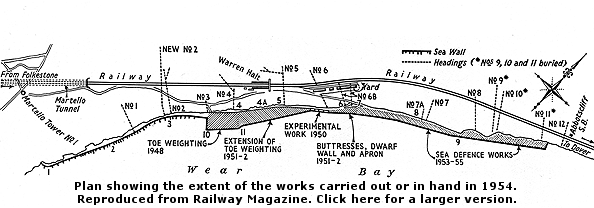
The line eventually reached Dover on 27 January 1844. Following the official opening on 6 February the passenger service between London and Dover Town began the following day. Six trains per day were provided in each direction.
Initially the SER showed interest in attracting tourists to Dover by offering excursion fares. They also introduced ships from Dover to Ostend; but the company’s major interest was the promotion of Folkestone Harbour.
One of the problems that SER constantly faced was that from Folkestone to Dover the tracks were – and still are – so close to the cliffs and sea. The area is known to have been liable to extensive landslips, the first recorded slip having taken place in 1765. On 14 November 1875 there was a severe storm that wrecked groynes and severely damaged the Town station roof, and the track was flooded. Two years later the line was closed for two months due to a 60,000 ton landslide, and it was mooted that SER would not reopen it. Sir Edward Watkin, SER chairman, blamed the rumour on his adversaries at LCDR. He visited the scene of devastation and later arranged for an official reopening after three months’ closure. On Sunday 20 March 1881 the line was again buried under about 20ft of chalk, just west of Abbotscliffe. Eight landslips were recorded before the turn of the twentieth century.
 On 19 December 1915, a landslide resulted in the entire undercliff supporting the main line moving towards the sea causing approximately 1.9 million cubic yards of chalk to slip or fall completely; the incident blocked a mile of track between the Martello and Abbotscliffe tunnels. The movement occurred over the whole length of the Warren and several cliffs collapsed resulting in the chalk fluidising and burying the rail lines with up to 65ft of debris and creating a flow 230ft out to sea. The maximum displacement was about 165ft near the centre of the disturbance. On 19 December 1915, a landslide resulted in the entire undercliff supporting the main line moving towards the sea causing approximately 1.9 million cubic yards of chalk to slip or fall completely; the incident blocked a mile of track between the Martello and Abbotscliffe tunnels. The movement occurred over the whole length of the Warren and several cliffs collapsed resulting in the chalk fluidising and burying the rail lines with up to 65ft of debris and creating a flow 230ft out to sea. The maximum displacement was about 165ft near the centre of the disturbance.
Soldiers stationed in the signal box managed to slow the 6.10pm Ashford to Dover service at the mouth of the Martello Tunnel and, although the train came to a halt partly on the landslide derailing some of the coaches, the passengers and crew were able to walk back to Folkestone Junction along the beach and no one was injured. This was one of the largest landslides in Kent.
After consultation with the Board of Trade the SECR decided that the blockage could not be removed during the War. Thus, passengers who wished to travel from Folkestone to Dover were faced with a long, arduous journey as Dover was under military rule and they could not enter the town except by rail. Thus they had to leave Folkestone on the Elham Valley Line to Canterbury then head back to Dover on the old LCDR line. For the remainder of the War the Admiralty used the tunnels to store mines and shells for locally based warships. During the four-year closure, drainage adits were bored from beach level up through the complex in an attempt to halt further coastal erosion, but small landslips continued to occur periodically.
The reopening of the railway between Dover and Folkestone took place on 11 August 1919, the line having been reconstructed during the spring and early summer. SECR became part of Southern Railway that came into operation on 1 January 1923.
Tickets from Michael Stewart. Route map drawn by Alan Young.
Click here to see a film of a train journey between Folkestone Junction and Dover Priory in the 1920s including a view of Folkestone Warren Halt.
Click here to see the article ‘Coast Erosion Works in Folkestone Warren’ reproduced from Railway Magazine - September 1954 . A works depot with
Sources:
See also: Folkestone (temporary station), Folkestone East, Folkestone Harbour, Shakespeare Cliff Halt, Archcliffe Junction Staff Halt, Dover Town, Dover Admiralty Pier, Dover Prince of Wales Pier, Dover Marine/Western Docks
& Dover Harbour
See also:
Detailed history of Shakespeare Colliery with many photos.
Detailed history of the first Channel Tunnel attempt in 1880 |

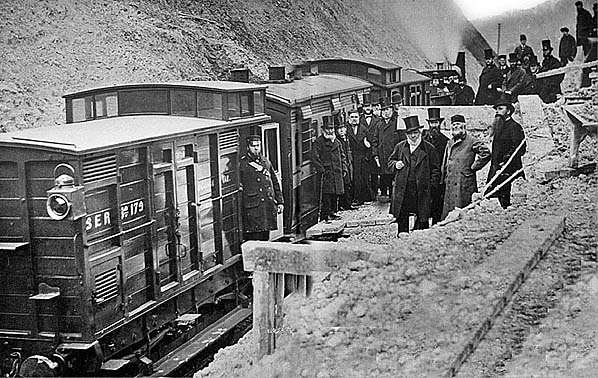

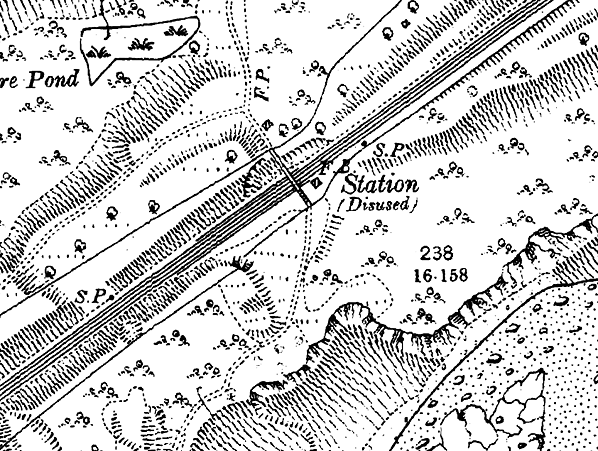
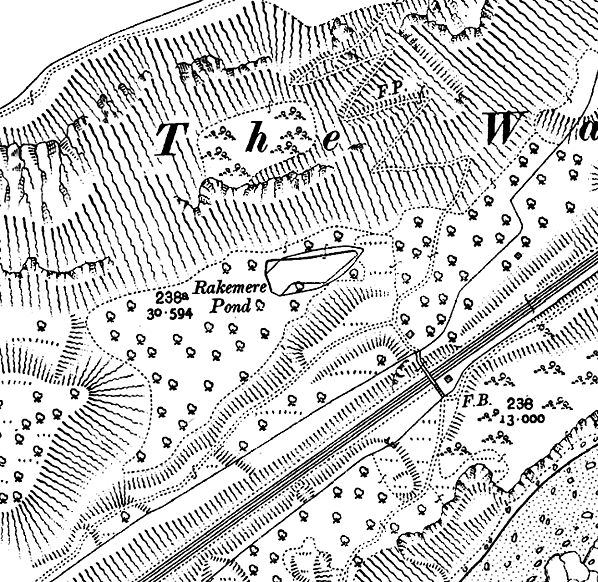
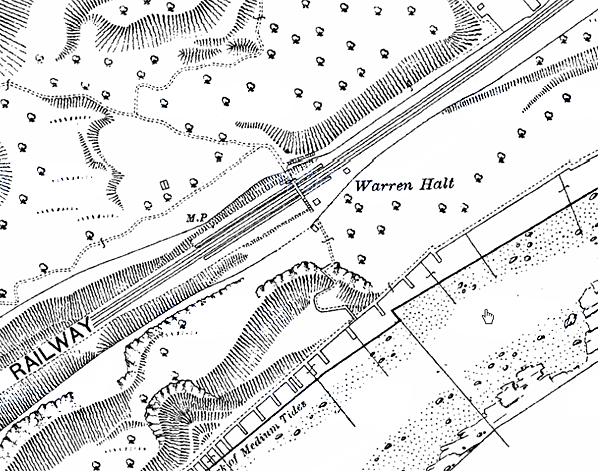
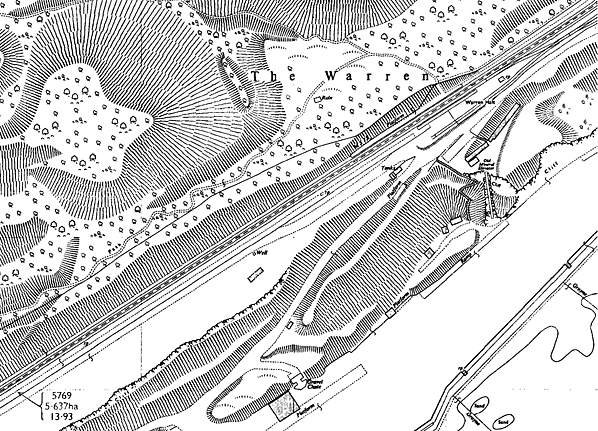
warren_old5.jpg)
warren_old17.jpg)
warren_old12.jpg)
warren_old39.jpg)
warren_old18.jpg)
warren_old19.jpg)
warren_old23.jpg)
warren_old10.jpg)
 The Warren was still a popular picnic spot in Edwardian times, and a nearby tea chalet and children's playground served hundreds of visitors daily. A new halt opened on the site 22 years later on 1 June 1908 for summer use only. The 1910 timetable shows it being open from May - September. Initially it appeared in the Dover to Sandgate timetable but in its last year it moved to the Elham Valley timetable. According to National Archive evidence it closed in September 1915 although it last appeared in a timetable in November 1915.
The Warren was still a popular picnic spot in Edwardian times, and a nearby tea chalet and children's playground served hundreds of visitors daily. A new halt opened on the site 22 years later on 1 June 1908 for summer use only. The 1910 timetable shows it being open from May - September. Initially it appeared in the Dover to Sandgate timetable but in its last year it moved to the Elham Valley timetable. According to National Archive evidence it closed in September 1915 although it last appeared in a timetable in November 1915.
 On 19 December 1915, a landslide resulted in the entire undercliff supporting the main line moving towards the sea causing approximately 1.9 million cubic yards of chalk to slip or fall completely; the incident blocked a mile of track between the Martello and Abbotscliffe tunnels. The movement occurred over the whole length of the Warren and several cliffs collapsed resulting in the chalk fluidising and burying the rail lines with up to 65ft of debris and creating a flow 230ft out to sea. The maximum displacement was about 165ft near the centre of the disturbance.
On 19 December 1915, a landslide resulted in the entire undercliff supporting the main line moving towards the sea causing approximately 1.9 million cubic yards of chalk to slip or fall completely; the incident blocked a mile of track between the Martello and Abbotscliffe tunnels. The movement occurred over the whole length of the Warren and several cliffs collapsed resulting in the chalk fluidising and burying the rail lines with up to 65ft of debris and creating a flow 230ft out to sea. The maximum displacement was about 165ft near the centre of the disturbance.
 The engineer of the Dover line was William Cubitt who was also engineer of the London & Croydon Railway. The chosen route, which passed over the lines of three other companies, would start at London Bridge, from where it would use London & Greenwich metals as far as Southwark and then turn south towards Croydon. From a junction with the London & Croydon at Norwood the Dover line would then share the London & Brighton main line to Redhill where it would turn east towards Tonbridge, Ashford and Folkestone. Construction began in 1838 at several places simultaneously. The L&BR line to Redhill opened on 12 July 1841. The line between Redhill and Ashford was almost straight with few engineering difficulties. The SER line from Redhill to Tonbridge opened on 26 May 1842, when SER train services began. The line reached Ashford on 1 December 1842 and the outskirts of Folkestone by 28 June 1843.
The engineer of the Dover line was William Cubitt who was also engineer of the London & Croydon Railway. The chosen route, which passed over the lines of three other companies, would start at London Bridge, from where it would use London & Greenwich metals as far as Southwark and then turn south towards Croydon. From a junction with the London & Croydon at Norwood the Dover line would then share the London & Brighton main line to Redhill where it would turn east towards Tonbridge, Ashford and Folkestone. Construction began in 1838 at several places simultaneously. The L&BR line to Redhill opened on 12 July 1841. The line between Redhill and Ashford was almost straight with few engineering difficulties. The SER line from Redhill to Tonbridge opened on 26 May 1842, when SER train services began. The line reached Ashford on 1 December 1842 and the outskirts of Folkestone by 28 June 1843.
 On 19 December 1915, a landslide resulted in the entire undercliff supporting the main line moving towards the sea causing approximately 1.9 million cubic yards of chalk to slip or fall completely; the incident blocked a mile of track between the Martello and Abbotscliffe tunnels. The movement occurred over the whole length of the Warren and several cliffs collapsed resulting in the chalk fluidising and burying the rail lines with up to 65ft of debris and creating a flow 230ft out to sea. The maximum displacement was about 165ft near the centre of the disturbance.
On 19 December 1915, a landslide resulted in the entire undercliff supporting the main line moving towards the sea causing approximately 1.9 million cubic yards of chalk to slip or fall completely; the incident blocked a mile of track between the Martello and Abbotscliffe tunnels. The movement occurred over the whole length of the Warren and several cliffs collapsed resulting in the chalk fluidising and burying the rail lines with up to 65ft of debris and creating a flow 230ft out to sea. The maximum displacement was about 165ft near the centre of the disturbance. Home Page
Home Page